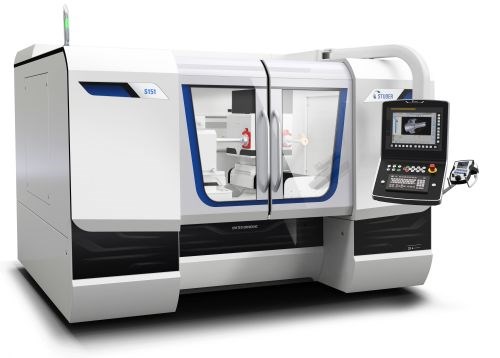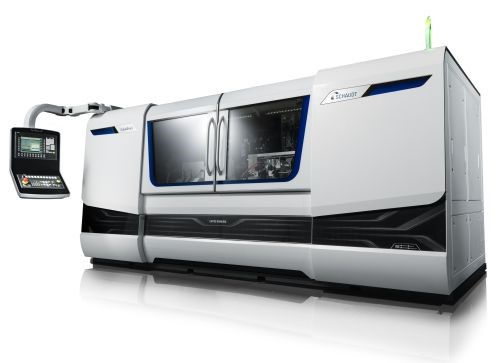Cylindrical Grinding Technology in Motion
United Grinding's annual Motion Meeting in Thun, Switzerland, highlights the group’s latest developments in cylindrical grinding. News from this year’s event includes the introduction of new models that broaden the range of ID and OD cylindrical grinding in the Studer line.
Share





“The Cylindrical Grinding Universe” was the theme for United Grinding’s 2015 Motion Meeting in Switzerland. This theme was particularly appropriate because a key point was the expansion of ID grinding capability to provide universal coverage of the full range of workpiece sizes.
Every year, United Grinding hosts a gathering of its sales partners and trade press editors from around the world. The purpose of this annual ‘Motion Meeting” in Thun, Switzerland earlier this month, was to highlight the group's latest developments in grinding technology, especially in the area of cylindrical grinding, which includes the Studer, Schaudt and Mikrosa brands. United Grinding also used this occasion to deliver its prestigious Fritz Studer Award for innovative research in machine tool or grinding technology.
Topping the list of new products introduced at the event are the Studer S131 and S151 cylindrical grinding machines, which are built on the innovative S141 cylindrical grinding platform. The S141 platform is distinguished by ID and OD grinding capability enabled by a grinding spindle turret that accommodates as many as four grinding spindles. Both internal and external grinding operations can be completed in one setup to enhance accuracy and reduce non-cut times.
The S131 is smaller than the S141. It has a swing diameter over the table of 250 mm (9.8 inches) and a maximum grinding length of 175 mm (6.9 inches) for ID grinding and 125 mm (4.9 inches) for OD grinding. It accommodates workpieces as long as 300 mm (11.8 inches).

The S131 is a compact ID/OD grinder for smaller work pieces.
For reference, the S141 is available in models for machining workpieces with maximum lengths of 300, 700 or 1,300 mm (11.81, 27.56 or 51.18 inches) and IDs ranging to 250 mm (9.84 inches).
To complete the series, the S151 is larger than the S141. The new S151 features a swing diameter over the table of 550 mm (21.6 inches) and a maximum grinding of length of 400 mm (15.7 inches) for ID work and 150 mm (5.9 inches) for OD work. It accommodates workpieces with a maximum length of 700 mm (27.5 inches).

The S151 grinds workpieces as long as 700 mm (27.5 inches).
Studer’s line of ID/OD grinders now covers the range of shaft diameters and lengths with no gaps for both ID and OD capability for complete grinding in one clamping. In addition, all of the machines share the same ergonomics and clean, streamlined styling of the enclosure and pendant-mounted control unit.
Another recent product worthy of mention is the CrankGrind, a crankshaft grinding machine from Schaudt. Cosmetically, this grinder sports that “new look” that represents the unified corporate identity within the Cylindrical Grinding Group as well as the company-wide emphasis on functionality and ergonomics. More important is its capability. The CrankGrind is designed to do rough- and finish-grinding of both main and pin bearings on automotive crankshafts, all in one setup on one machine.

The Schaudt CrankGrind is designed to be a “superproductive” grinder for the complete grinding of automotive crankshafts.
The Motion Meeting also affirmed Studer’s leadership in energy efficiency, which is a concern among all machine tool builders and end users. Studer’s multi-prong approach may be a model for comprehensive energy management in industrial equipment. For detailed commentary, click here.
A further highlight of the meeting was the presentation of the 2014 Fritz Studer Award to Dr. Eduardo Weingärtner from the Swiss Federal Institute of Technology Zürich. Dr. Weingärtner’s work pioneered the application of the wire EDM process for on-machine dressing of metal bonded grinding wheels. This research was instrumental in the introduction of the Studer WireDress system detailed here.
Finally, as a bonus for visiting trade press editors, a tour of United Grinding's Mägerle brand was arranged in Fehraltdorf prior to the conclave in Thun. Mägerle, part of the company’s surface and profile grinding group, specializes in large, multi-axis grinding machines. These highly engineered systems are custom-built from flexible modules to combine unique applications with proven design concepts. Although Mägerle grinders represent some of the most demanding and advanced applications in grinding, the company continues to rely on a solid foundation of traditional skills such as hand scraping of ways for mechanical accuracy. In fact, the company's apprenticeship program aggressively courts young talent to replenish its highly skilled workforce, and is a model for sustaining the thoroughly Swiss tradition of precision and meticulous craftsmanship.

Although Magerle does not produce “standard” models of grinders, it does offer distinct product ranges, including the MFP line of multi-axis surface and profile grinders. The MFP 50 shown here is part of a grinding cell for a jet engine manufacturer. The new styling of the MFP grinders reflects the corporate redesign.
Related Content
How to Determine the Currently Active Work Offset Number
Determining the currently active work offset number is practical when the program zero point is changing between workpieces in a production run.
Read MoreLean Approach to Automated Machine Tending Delivers Quicker Paths to Success
Almost any shop can automate at least some of its production, even in low-volume, high-mix applications. The key to getting started is finding the simplest solutions that fit your requirements. It helps to work with an automation partner that understands your needs.
Read MoreHow to Mitigate Chatter to Boost Machining Rates
There are usually better solutions to chatter than just reducing the feed rate. Through vibration analysis, the chatter problem can be solved, enabling much higher metal removal rates, better quality and longer tool life.
Read MoreInside the Premium Machine Shop Making Fasteners
AMPG can’t help but take risks — its management doesn’t know how to run machines. But these risks have enabled it to become a runaway success in its market.
Read MoreRead Next
Setting Up the Building Blocks for a Digital Factory
Woodward Inc. spent over a year developing an API to connect machines to its digital factory. Caron Engineering’s MiConnect has cut most of this process while also granting the shop greater access to machine information.
Read MoreRegistration Now Open for the Precision Machining Technology Show (PMTS) 2025
The precision machining industry’s premier event returns to Cleveland, OH, April 1-3.
Read MoreBuilding Out a Foundation for Student Machinists
Autodesk and Haas have teamed up to produce an introductory course for students that covers the basics of CAD, CAM and CNC while providing them with a portfolio part.
Read More































